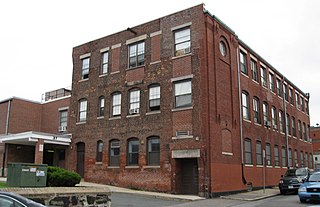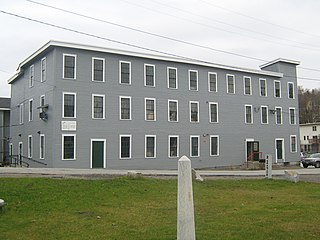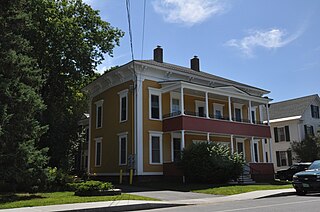
The Berger Factory is a historic factory building at 37 Williams Street in Boston, Massachusetts. Built in 1902, it was home to one of the nation's first manufacturers of precision engineering and surveying instruments, and a surviving example of Roxbury's late 19th-century industrial development. It was listed on the National Register of Historic Places in 1980, and now houses residences.

The American Waltham Watch Company Historic District encompasses the former factory of the Waltham Watch Company, the leading American watch manufacturer of the 19th century and the city's largest employer. Located on Crescent Street and the banks of the Charles River, the surviving elements of its manufacturing facility date from the 1870s to the 1910s, and include particularly fine industrial Romanesque architecture. The buildings have been converted to a variety of commercial, industrial and residential uses since they ceased being used for watchmaking in the 1950s. The complex was listed on the National Register of Historic Places in 1989.

The Richmond Congregational Church is a historic church at 20 Church Street in Richmond, Vermont, United States. Built in 1903-04, it is a significant local example of Colonial Revival architecture, designed by prominent Vermont architect Walter R. B. Willcox. It was listed on the National Register of Historic Places in 2001. The congregation is affiliated with the United Church of Christ; the minister is Rev. Katelyn Macrae.

The Kraus Corset Factory is a historic industrial property at 33 Roosevelt Drive in Derby, Connecticut, United States. The oldest portion of the large brick building, built in 1879, faces Third Street, while a c. 1910 addition extends along Roosevelt Drive. It is the only major building to survive from Derby's period of corset manufacturing. It was built by Sidney Downs, one of Derby's leading businessmen of the period. The building was listed on the National Register of Historic Places on February 12, 1987. It has been converted into apartments.

The Madison Candy Company is a candy factory built in 1903 a half mile east of the capitol in Madison, Wisconsin. In 1997 it was added to the National Register of Historic Places.

The Holman & Merriman Machine Shop, also known as the Derby Shop, Goodnow Pail Factory, L. A. Carpenter Machine Shop, and Streeter Shop, is an historic industrial building at 63 Canal Street in Hinsdale, New Hampshire. This three-story brick building, built in 1837, is the only building with a clerestory roof in Hinsdale, and one of only four in the state. It is also distinctive as the only known example in the state of a building purpose-built as a large-scale cooperage. The building was listed on the National Register of Historic Places in December 2007, and the New Hampshire State Register of Historic Places in January 2007.

The Kazon Building is a historic industrial building at 50 Marble Street in West Rutland, Vermont. Built in 1929, it is a well-preserved local example of a purpose-built garment factory, built by Louis Kazon, a leading local businessman in that industry. It was listed on the National Register of Historic Places in 2004. It has been converted to mixed office and residential use.

The Frog Hollow Stone Mill, or as it is now referred to, The Stone Mill, is a historic industrial building at 3 Mill Street in Middlebury, Vermont. Built in 1840, it is an important local reminder of the town's industrial past, and was listed on the National Register of Historic Places in 1973. It presently houses a restaurant, a public market, event space and four hotel rooms as part of an extensive renovation conducted in 2019.

Salisbury Town Hall is a historic municipal building at Maple and Prospect streets in Salisbury, Vermont. Built in 1869, it is a fine local example of Greek Revival architecture, and has served the rural community in a variety of ways: as town hall, library, and as educational facility. It was listed on the National Register of Historic Places in 1995.

The Beck and Beck Granite Shed is a historic granite shed at 34 Granite Street in the city of Barre, Vermont. Built in 1933, it is a rare surviving example of a rectangular granite shed, a late style of granite processing facility. The Beck and Beck Company was started by the area's first German immigrants, and operated until 1960. The building now houses a non-profit and store that repurposes and recycles building materials. It was listed on the National Register of Historic Places in 2011.

The Fairfield Street School is a historic school building at 78 Fairfield Street in the city of St. Albans, Vermont. Built in 1911, it served as a school until 1970, and is now converted into residential use. It is a prominent local example of Colonial Revival architecture, designed by Burlington architect Frank Lyman Austin. It was listed on the National Register of Historic Places in 1996.

The National Clothespin Factory is a historic industrial building at One Granite Street in Montpelier, Vermont. Built in 1918, it is a significant local example of an early 20th-century wood-frame factory, and was home to the nation's last manufacturer of wooden clothespins. Now adapted for other uses, the building was listed on the National Register of Historic Places in 2005.

Moquin's Bakery, also known locally as the Biscuit Factory and the National Biscuit Company, is a historic former industrial facility at 78 Rose Street in Burlington, Vermont. Built in 1915 by a local bakery, it was acquired and enlarged by the National Biscuit Company, which operated here until 1969. The building was listed on the National Register of Historic Places in 1997 for its economic and commercial historic significance, and has since then been converted into residences.

The Dr. B.J. Kendall Company is a historic industrial facility at 228 North Main Street in the Enosburg Falls village of Enosburgh, Vermont. Built in 1880, it was for many years the site where "Kendall's Spavin Cure", a treatment for a horse ailment, was manufactured and marketed. This business was one of the town's economic successes, its owners contributing significantly to its architectural heritage. The building was listed on the National Register of Historic Places in 1993; as of 2016, it is standing vacant.

The Richford Primary School is a historic school building at 140 Intervale Avenue in Richford, Vermont. Built in 1903 to address an overcrowding problem in the local schools, it served the town until 1968, and has since been converted into residential use. It was listed on the National Register of Historic Places in 2004.

The Porter Screen Company is a historic former industrial facility at 110 East Spring Street in Winooski, Vermont. Developed beginning 1910–11, this mill complex was an important secondary industrial employer in the city, shipping window screens and other housing parts nationwide. The facility, now converted to senior housing, was listed on the National Register of Historic Places in 1979.

The Wheelock Law Office is a historic commercial building at 135 North Main Street in the city of Barre, Vermont. Built in 1871 for a prominent local lawyer, it is a fine example of Second Empire architecture, and a rare surviving domestically scaled building in an area now primarily filled with larger commercial buildings. It was listed on the National Register of Historic Places in 1975.

The Willard Manufacturing Company Building is a historic factory building at 25 Stowell Street in the city of St. Albans, Vermont. Built in 1896, the building saw industrial uses continuously until 2006, retaining many original early period features. It was listed on the National Register of Historic Places in 2006.

The Winooski Block is a historic commercial building at 1 through 17 East Allen Street in downtown Winooski, Vermont. Built in 1867, it is the only major building to survive the city's urban renewal activities of the 1970s, and is a fine example of post-Civil War commercial architecture. It was listed on the National Register of Historic Places in 1974.

The Shearer and Corser Double House is a historic house at 592 Summer Street in St. Johnsbury, Vermont. Built as a school about 1854, it has had a history of varied uses and prominent local owners, and has high quality Colonial Revival and Italianate features. It was listed on the National Register of Historic Places in 1994.























